

As with any time in your pregnancy, if you experience leaking fluid or heavy bleeding afterwards, call your healthcare provider. “While messy, this is not generally harmful,” he says. It’s a safe procedure, but Costescu says in very rare cases your water will break inadvertently. “One sweep might not do anything, but if you have a sweep at weeks 38, 39 and 40, it’s the cumulative effect of those sweeps,” says Bacon. You may go into active labour within a few hours, a few days, or not at all-it depends on how ready your body is. It’s a completely optional procedure-even if your caregiver suggests it. Contescu says some women even request a stretch and sweep to help get labour started, particularly if they have a history of going past their due date. The main purpose of a stretch and sweep is to reduce the need for a medical induction after the due date, says Dustin Costescu, an obstetrician in Hamilton, Ont. “Because it causes a natural release of chemicals, it is less risky than medications used for induction such as oxytocin or prostaglandin gels,” he explains. Why do you get a membrane sweep?Ī stretch and sweep is not an induction rather, it’s an equipment-free, drug-free way to coax someone already in late pregnancy into spontaneous labour.

Alix Bacon, a registered midwife in Ladner, BC, says while one finger is required for a membrane sweep, a stretch needs two fingers to be able to fit through the cervix in order to “literally stretch those fingers apart.” If your cervix isn’t ready to be widened, this part of the procedure won’t be done, she says. The “stretch,” which refers to gently widening the inner part of the cervix, is meant to further stimulate labour. “The hope is to accelerate that onset of labour by the increase of prostaglandins,” explains George Carson, a Regina-based obstetrician. This “sweep,” releases prostaglandins, which are chemicals that help soften and open the cervix for delivery. Late in pregnancy, a doctor or midwife inserts a gloved finger through the cervical canal and uses a sweeping motion to separate the membrane from the cervix. (The great news: It’s not as bad as you might think.) How does a stretch and sweep work?Īlso referred to as a membrane sweep, a membrane stripping or simply a sweep, this technique involves gently lifting the amniotic sac-or fetal membrane-from the cervix and lower part of the uterus. Is it worth the additional pain and discomfort you might endure? Here’s what you need to know about what happens in the procedure, why it’s done and how you’ll feel both during and after. When you’re so pregnant and uncomfortable you can barely roll over in bed, you may not know what to think when your doctor or midwife suggests an even more uncomfortable procedure to hurry up labour: a stretch and sweep.


 0 kommentar(er)
0 kommentar(er)
